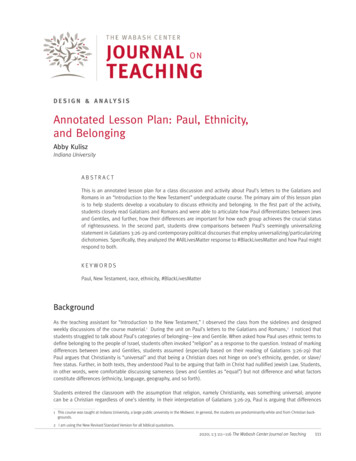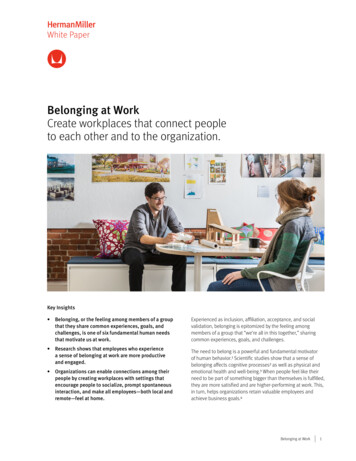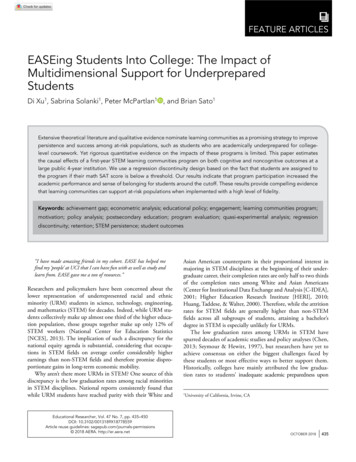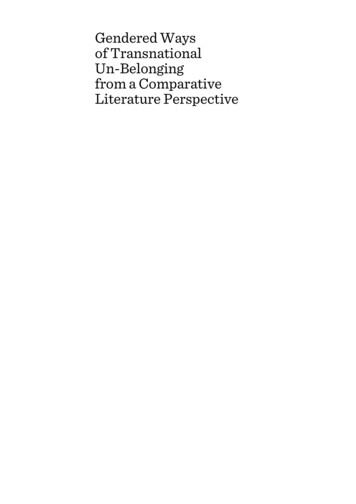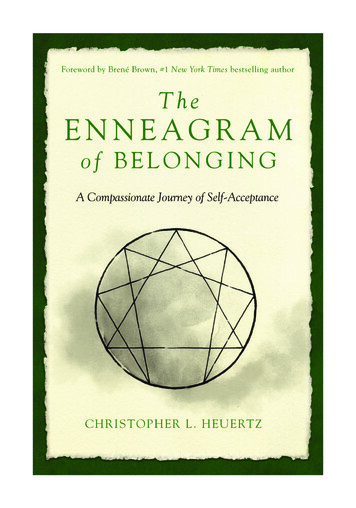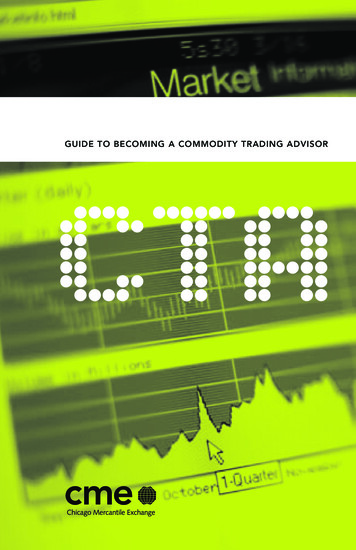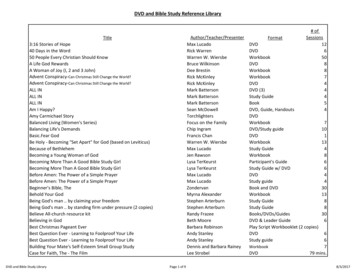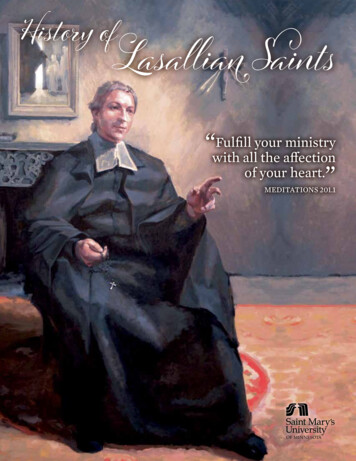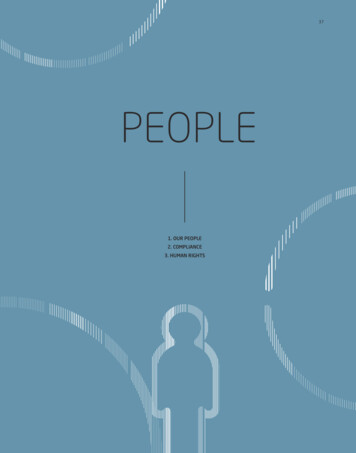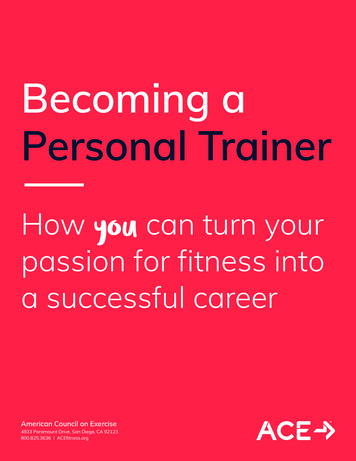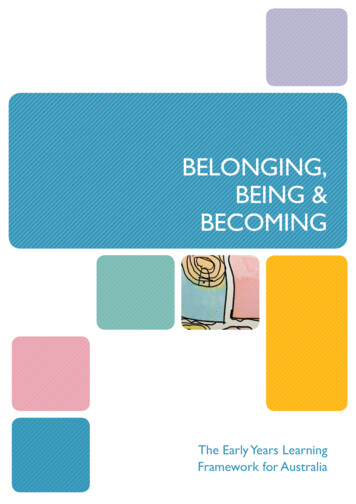
Transcription
BELONGING,BEING &BECOMINGThe Early Years LearningFramework for Australia
Produced by the Australian Government Department of Education, Employment and WorkplaceRelations for the Council of Australian Governments. Commonwealth of Australia 2009ISBN 978-0-642-77873-4This work is copyright. Apart from any use as permitted under the Copyright Act 1968, no part may bereproduced by any process without prior written permission from the Commonwealth. Requests and inquiriesconcerning reproduction and rights should be addressed to the Commonwealth Copyright Administration,Attorney-General’s Department, Robert Garran Offices, National Circuit, Barton ACT 2600 or posted athttp://www.ag.gov.au/cca
CONTENTSINTRODUCTION5A VISION FOR CHILDREN’S LEARNINGElements of the FrameworkChildren’s Learning799EARLY CHILDHOOD PEDAGOGY11PRINCIPLES12PRACTICE14LEARNING OUTCOMES FOR CHILDREN BIRTH TO 5 YEARSOutcome 1: Children have a strong sense of identity1920Children feel safe, secure, and supported21Children develop their emerging autonomy, inter-dependence, resilienceand sense of agency22Children develop knowledgeable and confident self identities23Children learn to interact in relation to others with care, empathy and respect24Outcome 2: Children are connected with and contribute to their world25Children develop a sense of belonging to groups and communities andan understanding of the reciprocal rights and responsibilities necessaryfor active community participation26Children respond to diversity with respect27Children become aware of fairness28Children become socially responsible and show respect for the environment29Outcome 3: Children have a strong sense of wellbeing30Children become strong in their social and emotional wellbeing31Children take increasing responsibility for their own health and physical wellbeing32Outcome 4: Children are confident and involved learners33Children develop dispositions for learning such as curiosity, cooperation,confidence, creativity, commitment, enthusiasm, persistence, imaginationand reflexivity34Children develop a range of skills and processes such as problem solving,inquiry, experimentation, hypothesising, researching and investigating35Children transfer and adapt what they have learned from one context to another36Children resource their own learning through connecting with people, place,technologies and natural and processed materials37BELONGING, BEING & BECOMING The Early Years Learning Framework for Australia3
Outcome 5: Children are effective communicators438Children interact verbally and non-verbally with others for a range of purposes40Children engage with a range of texts and gain meaning from these texts41Children express ideas and make meaning using a range of media42Children begin to understand how symbols and pattern systems work43Children use information and communication technologies to access information,investigate ideas and represent their thinking44GLOSSARY OF TERMS45BIBLIOGRAPHY47BELONGING, BEING & BECOMING The Early Years Learning Framework for Australia
INTRODUCTIONThis is Australia’s first national Early Years LearningFramework for early childhood educators. The aimof this document is to extend and enrich children’slearning from birth to five years and through thetransition to school.The Council of Australian Governments hasdeveloped this Framework to assist educatorsto provide young children with opportunities tomaximise their potential and develop a foundation forfuture success in learning. In this way, the Early YearsLearning Framework (the Framework) will contributeto realising the Council of Australian Governments’vision that:“All children have the best start in life to create abetter future for themselves and for the nation.” 1The Framework draws on conclusive internationalevidence that early childhood is a vital period inchildren’s learning and development. It has beendeveloped with considerable input from the earlychildhood sector, early childhood academics and theAustralian and State and Territory Governments.The Framework forms the foundation for ensuringthat children in all early childhood education and caresettings experience quality teaching and learning. Ithas a specific emphasis on play-based learning andrecognises the importance of communication andlanguage (including early literacy and numeracy) andsocial and emotional development. The Frameworkhas been designed for use by early childhoodeducators working in partnership with families,children’s first and most influential educators.Early childhood educators guided by the Frameworkwill reinforce in their daily practice the principles laidout in the United Nations Convention on the Rightsof the Child (the Convention). The Convention statesthat all children have the right to an education thatlays a foundation for the rest of their lives, maximisestheir ability, and respects their family, cultural andother identities and languages. The Convention alsorecognises children’s right to play and be activeparticipants in all matters affecting their lives.This document may complement, supplement orreplace individual State and Territory frameworks.The exact relationship will be determined byeach jurisdiction.More broadly, the Framework supports Goal 2 of theMelbourne Declaration on Education Goals for YoungAustralians2, that:All young Australians become: Successful learners Confident and creative individuals Active and informed citizens.Educators:early childhood practitioners who workdirectly with children in early childhoodsettings.1 Investing in the Early Years - a National Early Childhood Development Strategy, Council of Australian Governments2 On 5 December 2008, State, Territory and Commonwealth Ministers of Education meeting as the Ministerial Council on Education,Employment, Training and Youth Affairs, released the Melbourne Declaration on Educational Goals for Young Australians.1 Learning Framework includes reference to Starting Strong II2 2008, The Apology to the Stolen Generation)BELONGING, BEING & BECOMING The Early Years Learning Framework for Australia5
Children:refers to babies, toddlers and three to fiveyear olds, unless otherwise stated.The Melbourne Declaration also commits toimproved outcomes for Aboriginal and Torres StraitIslander young people and strengthening earlychildhood education.The Council of Australian Governments is committedto closing the gap in educational achievementbetween Indigenous and non-Indigenous Australianswithin a decade3. Early childhood education has acritical role to play in delivering this outcome.Recognising this, a specific document that provideseducators with additional guidance on ensuringcultural security for Aboriginal and Torres StraitIslander children and their families will be developedand made available to educators.Over time additional resources may be developed tosupport the application of this Framework.Play-based learning:a context for learning through whichchildren organise and make sense of theirsocial worlds, as they engage actively withpeople, objects and representations.3 The Council of Australian Governments - Communique - 3 July 2008. Indigenous Reform - Closing the Gap.6BELONGING, BEING & BECOMING The Early Years Learning Framework for Australia
A VISION FORCHILDREN’S LEARNINGAll children experience learning that is engagingand builds success for life.Fundamental to the Framework is a view of children’slives as characterised by belonging, being and becoming.From before birth children are connected tofamily, community, culture and place. Their earliestdevelopment and learning takes place through theserelationships, particularly within families, who arechildren’s first and most influential educators. Aschildren participate in everyday life, they developinterests and construct their own identities andunderstandings of the world.BELONGINGExperiencing belonging – knowing where and withwhom you belong – is integral to human existence.Children belong first to a family, a cultural group, aneighbourhood and a wider community. Belongingacknowledges children’s interdependence with othersand the basis of relationships in defining identities. Inearly childhood, and throughout life, relationships arecrucial to a sense of belonging. Belonging is central tobeing and becoming in that it shapes who children areand who they can become.“You belong in your housewith your family” – DongBEINGChildhood is a time to be, to seek and makemeaning of the world.“If you want to be a mermaidyou can imagine” – JazmineBeing recognises the significance of the here andnow in children’s lives. It is about the present andthem knowing themselves, building and maintainingrelationships with others, engaging with life’s joys andcomplexities, and meeting challenges in everyday life.The early childhood years are not solely preparationfor the future but also about the present.BECOMINGChildren’s identities, knowledge, understandings,capacities, skills and relationships change duringchildhood. They are shaped by many different eventsand circumstances. Becoming reflects this process ofrapid and significant change that occurs in the earlyyears as young children learn and grow. It emphasiseslearning to participate fully and actively in society.“When you keep planting plantsyou become a gardener” – OliviaBELONGING, BEING & BECOMING The Early Years Learning Framework for Australia7
Learning outcome:a skill, knowledge or disposition thateducators can actively promote in earlychildhood settings, in collaboration withchildren and families.The Framework conveys the highest expectationsfor all children’s learning from birth to five years andthrough the transitions to school. It communicatesthese expectations through the following fiveLearning Outcomes: Children have a strong sense of identity Children are connected with and contribute totheir world Children have a strong sense of wellbeing Children are confident and involved learners Children are effective communicators.The Framework provides broad direction for earlychildhood educators in early childhood settings tofacilitate children’s learning.8Early childhood settings:long day care, occasional care, family daycare, Multi-purpose Aboriginal Children’sServices, preschools and kindergartens,playgroups, creches, early interventionsettings and similar services.It guides educators in their curriculum decisionmaking and assists in planning, implementing andevaluating quality in early childhood settings. It alsounderpins the implementation of more specificcurriculum relevant to each local community andearly childhood setting.The Framework is designed to inspire conversations,improve communication and provide a commonlanguage about young children’s learning amongchildren themselves, their families, the broadercommunity, early childhood educators and otherprofessionals.BELONGING, BEING & BECOMING The Early Years Learning Framework for Australia
ELEMENTS OF THE FRAMEWORKCHILDREN’S LEARNINGThe Framework puts children’s learning at the coreand comprises three inter-related elements: Principles,Practice and Learning Outcomes (see Figure 1).All three elements are fundamental to early childhoodpedagogy and curriculum decision-making.The diversity in family life means that childrenexperience belonging, being and becoming in manydifferent ways. They bring their diverse experiences,perspectives, expectations, knowledge and skills totheir learning.Curriculum encompasses all the interactions,experiences, routines and events, planned andunplanned, that occur in an environment designedto foster children’s learning and development.The emphasis in the Framework is on the plannedor intentional aspects of the curriculum.Children’s learning is dynamic, complex and holistic.Physical, social, emotional, personal, spiritual, creative,cognitive and linguistic aspects of learning are allintricately interwoven and interrelated.Children are receptive to a wide range ofexperiences. What is included or excluded from thecurriculum affects how children learn, develop andunderstand the world.The Framework supports a model of curriculumdecision-making as an ongoing cycle. This involveseducators drawing on their professional knowledge,including their in-depth knowledge of each child.Working in partnership with families, educators usethe Learning Outcomes to guide their planning forchildren’s learning. In order to engage children activelyin learning, educators identify children’s strengths andinterests, choose appropriate teaching strategies anddesign the learning environment.Educators carefully assess learning to informfurther planning.Curriculum:in the early childhood setting curriculummeans ‘all the interactions, experiences,activities, routines and events, planned andunplanned, that occur in an environmentdesigned to foster children’s learning anddevelopment’. [adapted from Te Whariki]Pedagogy:early childhood educators’ professionalpractice, especially those aspectsthat involve building and nurturingrelationships, curriculum decision-making,teaching and learning.Play is a context for learning that: allows for the expression of personality anduniqueness enhances dispositions such as curiosity andcreativity enables children to make connections betweenprior experiences and new learning assists children to develop relationshipsand concepts stimulates a sense of wellbeing.Children actively construct their own understandingsand contribute to others’ learning. They recognisetheir agency, capacity to initiate and lead learning, andtheir rights to participate in decisions that affect them,including their learning.Viewing children as active participants and decisionmakers opens up possibilities for educators to movebeyond pre-conceived expectations about whatchildren can do and learn. This requires educators torespect and work with each child’s unique qualitiesand abilities.Educators’ practices and the relationships they formwith children and families have a significant effect onchildren’s involvement and success in learning. Childrenthrive when families and educators work together inpartnership to support young children’s learning.Children’s early learning influences their life chances.Wellbeing and a strong sense of connection, optimismand engagement enable children to develop a positiveattitude to learning.The Learning Outcomes section of the Frameworkprovides examples of evidence of children’s learningand the educator’s role.BELONGING, BEING & BECOMING The Early Years Learning Framework for Australia9
Holistic approachesLearningenvironmentsPlay-based curriculum and intentionalteachingResponsiveness tochildrenCultural competencePhysicaland social learning environmentsLearning throughplayof learning and transitionsContinuityof learningContinuityand transitionsIntentional teaching Assessment for learningAssessment for learningBEINGINGMOCsihoinpacntsES rienltaetrioieselilPLCI rsoitciva lfiaemsIN decpipo faimthi uityPR pans danr shwipitsh wenrdsiteyq yticersivaraciittysuhliocntf sthniep ornds qrsu e plsaptei pear taftoi tdoive eticcteiv, re ianretn ec iotyrfclure nuP eexsp ecutnf nedprreaSec Ge HighR oesmpmtiavCR renfliencgleRagoOnEAildrRNen ChildareC reINnGCh choildn havOnreieeCh ldrildr en nctpeadr a stro UTCOen havtwngChe icitiMEildr are c a st phaatend senserionenoofSare nfiden ng se ccoonmidtibu entieffe t an nse rmttnyeitctiv d ioe c nvo f wel iteos thom lved lbe eirinwomurldnic learn gato ersrsLONGINGEBBEFigure 1: Elements of the Early Years Learning FrameworkInvolvement:is a state of intense, whole heartedmental activity, characterised by sustainedconcentration and intrinsic motivation.Highly involved children (and adults)operate at the limit of their capacities,leading to changed ways of respondingand understanding leading to deep levellearning. (adapted from Laevers 1994)10Dispositions:enduring habits of mind and actions, andtendencies to respond in characteristicways to situations, for example,maintaining an optimistic outlook, beingwilling to persevere, approaching newexperiences with confidence. (Carr, 2001)BELONGING, BEING & BECOMING The Early Years Learning Framework for Australia
EARLY CHILDHOOD PEDAGOGYThe term pedagogy refers to the holistic nature ofearly childhood educators’ professional practice(especially those aspects that involve building andnurturing relationships), curriculum decision-making,teaching and learning. When educators establishrespectful and caring relationships with childrenand families, they are able to work together toconstruct curriculum and learning experiencesrelevant to children in their local context. Theseexperiences gradually expand children’s knowledgeand understanding of the world.Educators’ professional judgements are central to theiractive role in facilitating children’s learning. In makingprofessional judgements, they weave together their: professional knowledge and skills knowledge of children, families and communities awareness of how their beliefs and values impacton children’s learning personal styles and past experiences.They also draw on their creativity, intuition andimagination to help them improvise and adjusttheir practice to suit the time, place and context oflearning.Different theories about early childhood informapproaches to children’s learning and development.Early childhood educators draw upon a range ofperspectives in their work which may include: developmental theories that focus on describingand understanding the processes of change inchildren’s learning and development over time socio-cultural theories that emphasise thecentral role that families and cultural groupsplay in children’s learning and the importanceof respectful relationships and provide insightinto social and cultural contexts of learning anddevelopment socio-behaviourist theories that focus on the roleof experiences in shaping children’s behaviour critical theories that invite early childhoodeducators to challenge assumptions aboutcurriculum, and consider how their decisions mayaffect children differently post-structuralist theories that offer insights intoissues of power, equity and social justice in earlychildhood settings.Drawing on a range of perspectives and theories canchallenge traditional ways of seeing children, teachingand learning, and encourage educators, as individualsand with colleagues, to: investigate why they act in the ways that they do discuss and debate theories to identify strengthsand limitations recognise how the theories and beliefs that theyuse to make sense of their work enable but alsolimit their actions and thoughts consider the consequences of their actions forchildren’s experiences find new ways of working fairly and justly.BELONGING, BEING & BECOMING The Early Years Learning Framework for Australia11
OUTCOMENINGARLEINGOMCBEINGPRACTICEBEThe following are five Principles that reflectcontemporary theories and research evidenceconcerning children’s learning and earlychildhood pedagogy. The Principles underpin practicethat is focused on assisting all children to makeprogress in relation to the Learning Outcomes.that families are children’s first and most influentialteachers. They create a welcoming environmentwhere all children and families are respected andactively encouraged to collaborate with educatorsabout curriculum decisions in order to ensure thatlearning experiences are meaningful.1. Secure, respectful andreciprocal relationshipsPartnerships are based on the foundations ofunderstanding each other’s expectations andattitudes, and build on the strength of each others’knowledge.Educators who are attuned to children’s thoughtsand feelings, support the development of a strongsense of wellbeing. They positively interact with theyoung child in their learning.Research has shown that babies are both vulnerableand competent. Babies’ first attachments withintheir families and within other trusting relationshipsprovide them with a secure base for explorationand learning.Through a widening network of securerelationships, children develop confidence and feelrespected and valued. They become increasingly ableto recognise and respect the feelings of others andto interact positively with them.Educators who give priority to nurturingrelationships and providing children withconsistent emotional support can assist childrento develop the skills and understandings theyneed to interact positively with others. They alsohelp children to learn about their responsibilitiesto others, to appreciate their connectednessand interdependence as learners, and to valuecollaboration and teamwork.2. PartnershipsLearning outcomes are most likely to beachieved when early childhood educators workin partnership with families. Educators RSLONGINGBEIn genuine partnerships, families and early childhoodeducators: value each other’s knowledge of each child value each other’s contributions to and roles ineach child’s life trust each other communicate freely and respectfully witheach other share insights and perspectives about each child engage in shared decision-making.Partnerships also involve educators, families andsupport professionals working together to explorethe learning potential in every day events, routinesand play so that children with additional needsare provided with daily opportunities to learnfrom active participation and engagement in theseexperiences in the home and in early childhood orspecialist settings.3. High expectations and equityEarly childhood educators who are committed toequity believe in all children’s capacities to succeed,regardless of diverse circumstances and abilities.Children progress well when they, their parentsand educators hold high expectations for theirachievement in learning.BELONGING, BEING & BECOMING The Early Years Learning Framework for Australia
4. Respect for diversityThere are many ways of living, being and of knowing.Children are born belonging to a culture, whichis not only influenced by traditional practices,heritage and ancestral knowledge, but also by theexperiences, values and beliefs of individual familiesand communities. Respecting diversity means withinthe curriculum valuing and reflecting the practices,values and beliefs of families. Educators honour thehistories, cultures, languages, traditions, child rearingpractices and lifestyle choices of families. Theyvalue children’s different capacities and abilities andrespect differences in families’ home lives.Educators recognise that diversity contributes tothe richness of our society and provides a validevidence base about ways of knowing. For Australiait also includes promoting greater understandingof Aboriginal and Torres Strait Islander ways ofknowing and being.When early childhood educators respect thediversity of families and communities, and theaspirations they hold for children, they are able tofoster children’s motivation to learn and reinforcetheir sense of themselves as competent learners.They make curriculum decisions that uphold allchildren’s rights to have their cultures, identities,abilities and strengths acknowledged and valued,and respond to the complexity of children’s andfamilies’ lives.Educators think critically about opportunitiesand dilemmas that can arise from diversity andtake action to redress unfairness. They provideopportunities to learn about similarities anddifference and about interdependence and how wecan learn to live together.5. Ongoing learningand reflective practiceEducators continually seek ways to build theirprofessional knowledge and develop learningcommunities. They become co-learners with children,families and community, and value the continuity andrichness of local knowledge shared by communitymembers, including Aboriginal and Torres StraitIslander Elders.PRINCIPLESEducators recognise and respond to barriersto children achieving educational success. Inresponse they challenge practices that contributeto inequities and make curriculum decisions thatpromote inclusion and participation of all children.By developing their professional knowledge andskills, and working in partnership with children,families, communities, other services and agencies,they continually strive to find equitable and effectiveways to ensure that all children have opportunitiesto achieve learning outcomes.Reflective practice is a form of ongoing learning thatinvolves engaging with questions of philosophy, ethicsand practice. Its intention is to gather informationand gain insights that support, inform and enrichdecision-making about children’s learning. Asprofessionals, early childhood educators examinewhat happens in their settings and reflect on whatthey might change.Critical reflection involves closely examining allaspects of events and experiences from differentperspectives. Educators often frame their reflectivepractice within a set of overarching questions,developing more specific questions for particularareas of enquiry.Overarching questions to guide reflection include: What are my understandings of each child? What theories, philosophies and understandingsshape and assist my work? Who is advantaged when I work in this way?Who is disadvantaged? What questions do I have about my work? Whatam I challenged by? What am I curious about?What am I confronted by? What aspects of my work are not helped by thetheories and guidance that I usually draw on tomake sense of what I do? Are there other theories or knowledge thatcould help me to understand better what I haveobserved or experienced? What are they? Howmight those theories and that knowledge affectmy practice?A lively culture of professional inquiry is establishedwhen early childhood educators and those withwhom they work are all involved in an ongoingcycle of review through which current practicesare examined, outcomes reviewed and new ideasgenerated. In such a climate, issues relating tocurriculum quality, equity and children’s wellbeing canbe raised and debated.BELONGING, BEING & BECOMING The Early Years Learning Framework for Australia13
NINGAR planning and implementing learning through play intentional teaching creating physical and social learningenvironments that have a positive impact onchildren’s learning valuing the cultural and social contexts ofchildren and their families providing for continuity in experiences andenabling children to have successful transition assessing and monitoring children’s learningto inform provision and to support children inachieving learning outcomes.Holistic approachesHolistic approaches to teaching and learningrecognise the connectedness of mind, body andspirit4. When early childhood educators take aholistic approach they pay attention to children’sphysical, personal, social, emotional and spiritualwellbeing as well as cognitive aspects of learning.While educators may plan or assess with a focuson a particular outcome or component of learning,they see children’s learning as integrated andinterconnected. They recognise the connectionsINGOMCLEbeing responsive to childrenBE PRACTICEbetween children, families and communities andthe importance of reciprocal relationships andpartnerships for learning. They see learning as asocial activity and value collaborative learning andcommunity participation.An integrated, holistic approach to teaching andlearning also focuses on connections to the naturalworld. Educators foster children’s capacity tounderstand and respect the natural environmentand the interdependence between people, plants,animals and the land.Responsiveness to childrenEducators are responsive to all children’s strengths,abilities and interests. They value and build onchildren’s strengths, skills and knowledge to ensuretheir motivation and engagement in learning. Theyrespond to children’s expertise, cultural traditionsand ways of knowing, the multiple languages spokenby some children, particularly Aboriginal and TorresStrait Islander children, and the strategies used bychildren with additional needs to negotiate theirevery day lives.Scaffold:the educators’ decisions and actions thatbuild on children’s exisitng knowledge andskills to enhance their learning.4 Siraj-Blatchford, I., & Sylva, K. (2004). Researching pedagogy in English pre-schools. British Educational Research Journal, 30(5), 712-730.14BEINGadopting holistic approachesCHILDREN’SLEARNINGESPRACTICE PLCIThe principles of early childhood pedagogyunderpin practice. Educators draw on a richrepertoire of pedagogical practices to promotechildren’s learning by:INPRACTICEPROUTCOMESLONGINGBEBELONGING, BEING & BECOMING The Early Years Learning Framework for Australia
Educators are also responsive to children’sideas and play, which form an important basisfor curriculum decision-making. In response tochildren’s evolving ideas and interests, educatorsassess, anticipate and extend children’s learningvia open ended questioning, providing feedback,challenging their thinking and guiding their learning.They make use of spontaneous ‘teachable moments’to scaffold children’s learning.Responsive learning relationships are strengthenedas educators and children learn together and sharedecisions, respect and trust. Responsiveness enableseducators to respectfully enter children’s play andongoing projects, stimulate their thinking and enrichtheir learning.learning. They create learning environments thatencourage children to explore, solve problems,create and construct. Educators interact with babiesand children to build attachment. They use routinesand play experiences to do this. They also recognisespontaneous teachable moments as they occur,and use them to build on children’s learning. Earlychildhood educators work with young childrento promote and model positive ways to relate toothers. They actively support the inclusion of allchildren in play, help children to recognise whenplay is unfair and offer constructive ways to build acaring, fair
BELONGING, BEING & BECOMING The Early Years Learning Framework for Australia 7 A VISION FOR CHILDREN’S LEARNING BEING Childhood is a time to be, to seek and make meaning of the world. Being recognises the signifi cance of the here
